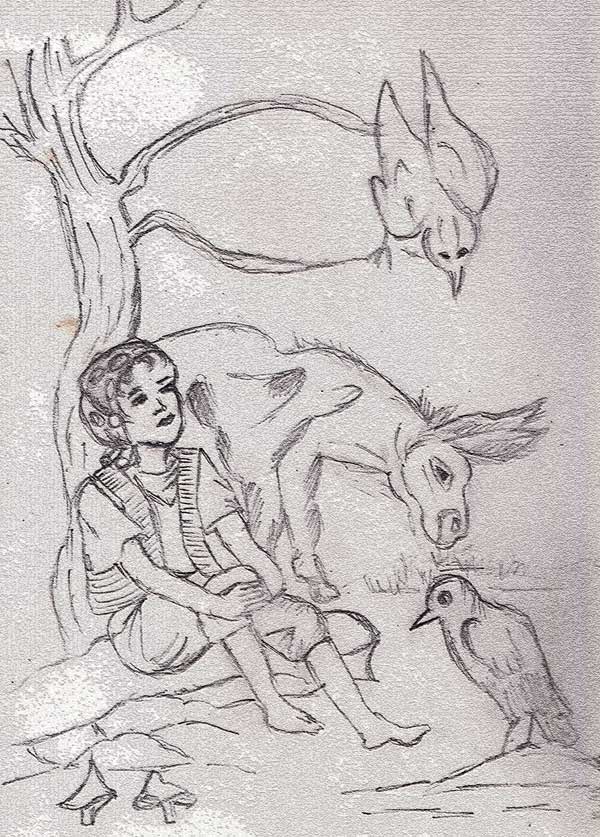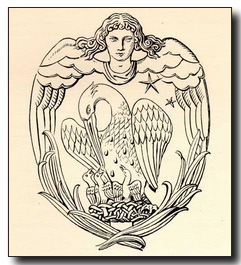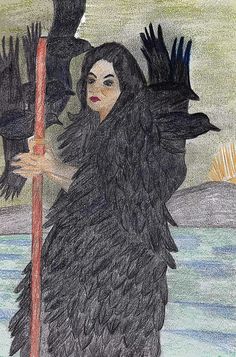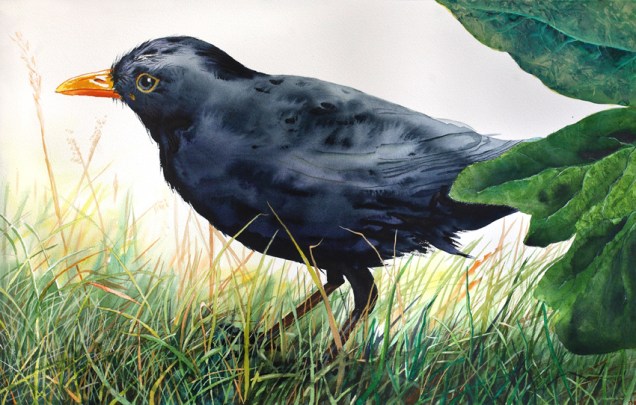Over 52 weeks I will be learning all about how to live and work creatively. My teachers are Aussie birds and animals. It is week three and the creative force has produced the Musk Lorikeet to build on the lessons that Australian birds, animals and habitat are initiating.

They talk with their beaks full of blossom
In a cascade of chatter as they sidle
Invisibly through the swaying treetops
They fly in a hurry as if all the gumnuts
Would disappear before they got to them
Geoffrey Dutton
Musk Lorikeets have been feeding on the fruit in my yard, hurling stone fruit onto the roof of the galvanised shed that the fruit tree spreads its branches over. The ground is covered with kernels, hastily discarded as the birds flit off looking for the next treat! These joyful creatures bring brightly coloured plumage and comic antics into my world.
The Rainbow Lorikeet and Musk Lorikeet have inspired rich poetic characterisations, with poets depicting them as gangs of unruly, chattering, aerodynamic, comical bandits. Geoffrey Dutton and Mark O’Connor are just two Australian poets who personify the spirit of these free-ranging, social creatures.
Lorikeets are full of silliness and humour, and they are also inquisitive about their surroundings. They remind the writer and artist to bring colour, humour and light into their work.
 Manuel Payno is a writer whose work brought as much joy as a flock of lorikeets. In the translator’s preface, Alan Fluckey describes the small riot that erupted when a ship, carrying copies of The Bandits from Rio Frio in its cargo, arrived in Mexico. Boxes were hastily opened and copies were sold within minutes as people greedily hustled to get their own personal copy. Book in hand Mexicans sat about in the open air reading to their neighbours! Rainbow chatter filled the air!
Manuel Payno is a writer whose work brought as much joy as a flock of lorikeets. In the translator’s preface, Alan Fluckey describes the small riot that erupted when a ship, carrying copies of The Bandits from Rio Frio in its cargo, arrived in Mexico. Boxes were hastily opened and copies were sold within minutes as people greedily hustled to get their own personal copy. Book in hand Mexicans sat about in the open air reading to their neighbours! Rainbow chatter filled the air!
Lorikeet and Payno come whirling into my world, reminding me to remind everyone to be exuberant and add colour to their writing; to write and paint about colourful places and colourful characters! Examine the work of Payno closely! Combine this with a copy of The Donkey Inside by Ludwig Bemelmans! Your work will be enriched!
Rainbow Lorikeets
by Mark O’Connor
To feed head-down in an aerial smother of honey and pollen
reassured by a rainbow chatter of siblings
changing tree on impulse
in case python or man is stalking,
reckless till then . . .
A frantic pillaging crew,
crimson-patched pirates screeching in plunder-frenzy,
ignoring the silver-eyes nervously feeding
under those orange scimitars of beak.
The first dozen leave in a second, headlong, a rapid
scatter of downward notes; greedy last tilts his head
and is traumatised by a blank grey-green
widowed of reds and orange.
Before long they’ll circle back.
Shrieks of “Saps up”, “Feed here!”,
churrs of “All’s well, Honey flows”,
screech of “Hawk’s shadow! Watch out!”
mute to the mating thrum
Bill-and-Coo, Tickle-and-Tweek.
Their world is millions of honey-dripping pores.
Free as a child with a million breasts to suckle,
the world’s glands, daytime and night,
at work making sweets for them.
“Comic book bandidos”, but equally
rainbow-motley clowns; with their walk-claws
they tread-cling, wading and stumbling
up loose sprays of blossom
as a lily-trotter walks floating weeds.
They clutch-bunch and jostle on rafts of leaf
buoyed there by bough-spring, then flare out
over forests where the tenth tree in rotation
is an oasis of dripping pompoms.
Their brush-tongues delving and combing
bully honey from bottle-brush florets
or bite them off short,
munching sweet mash.
This desert of unfruiting trees,
deluding the settlers with woody semblances,
is their land of nectar and pollen-bread, antipodean
paradise, where raucous workers thrive.
A good tree gives gallons a day
— but modestly, from flowers as dull as grasses,
pale cream or off-white, blanched foliage.
Birds themselves must play petal;
their stridulous yellows and blues and orange and red
flag out each tree of delights, proclaim the loud shrines
of fermenting, honeyed, winey abundance.
It is said the birds came from dinosaurs.
Rainbow dinosaurs.
Some Colourful Characters Who Populated Lemuria
Heather Blakey 2004 – 10


 Because the turkey is closely associated with the spirit of the Earth, it is also symbolic of feminine energies at work in our lives. This animal has been revered in ancient traditions as a symbol of fertility and abundance.
Because the turkey is closely associated with the spirit of the Earth, it is also symbolic of feminine energies at work in our lives. This animal has been revered in ancient traditions as a symbol of fertility and abundance.








 Situated at the Loddon River Ford at Newstead, Antares Iron Art Garden is an established art and sculpture garden created by Roger McKindley.
Situated at the Loddon River Ford at Newstead, Antares Iron Art Garden is an established art and sculpture garden created by Roger McKindley.
























 I quickly decided that blowflies are far from insignificant. They do make their presence felt! Blowflies have been deemed to be vehicles of death, decay and destruction; envoys of evil, sin and pestilence by the Christians. However, some African tribes celebrate a Fly-god, with the fly revered as an embodiment of the soul. As such flies are never killed.
I quickly decided that blowflies are far from insignificant. They do make their presence felt! Blowflies have been deemed to be vehicles of death, decay and destruction; envoys of evil, sin and pestilence by the Christians. However, some African tribes celebrate a Fly-god, with the fly revered as an embodiment of the soul. As such flies are never killed. As I sat at Dog Rocks I noted the call of the Kookaburra and the footfall of rock climbers clambering to find places to test their skills. But it was the brown butterflies who danced around me and who led me to find a small magic circle, formed by ancient granite.
As I sat at Dog Rocks I noted the call of the Kookaburra and the footfall of rock climbers clambering to find places to test their skills. But it was the brown butterflies who danced around me and who led me to find a small magic circle, formed by ancient granite. After watching a Pelican, patiently perched on its nest at St Leonard’s, Victoria, on the Australia Day long weekend I have been encouraged to emulate this bird. Ted Andrews talks about Still-hunting in this classic book, Animal-Wise.
After watching a Pelican, patiently perched on its nest at St Leonard’s, Victoria, on the Australia Day long weekend I have been encouraged to emulate this bird. Ted Andrews talks about Still-hunting in this classic book, Animal-Wise.  The elegant pelican animal totem is definitely an opportunist with style and finesse. In the wild, these large-billed birds perch themselves in the most advantageous position before swooping in to catch their prey. They wait patiently and focus intently, striking at the most perfect moment.
The elegant pelican animal totem is definitely an opportunist with style and finesse. In the wild, these large-billed birds perch themselves in the most advantageous position before swooping in to catch their prey. They wait patiently and focus intently, striking at the most perfect moment. Despite their size pelicans are light and buoyant. They can float like a schooner. A pelican in flight can quite suddenly plummet into the water and then pop up to the surface. Its system of air sacs under the skin makes it unsinkable.
Despite their size pelicans are light and buoyant. They can float like a schooner. A pelican in flight can quite suddenly plummet into the water and then pop up to the surface. Its system of air sacs under the skin makes it unsinkable.
 This practice reminded of a gift that I was given when I visited the
This practice reminded of a gift that I was given when I visited the  Possum urges us to see our life as being built upon the foundation of our ancestors; to wrap ourselves within a cloak and find anchorage with our ancestors.
Possum urges us to see our life as being built upon the foundation of our ancestors; to wrap ourselves within a cloak and find anchorage with our ancestors.



 Lorikeets are full of silliness and humour, and they are also inquisitive about their surroundings. These comical birds remind the writer and artist to be expressive and bring colour, humour and light into their work. Lorikeet has drawn me to examine Expressive Arts. Expressive Arts and Art Therapy are creative therapies. The concept of expressive art resonates for me because it honours the process, rather than the final product.
Lorikeets are full of silliness and humour, and they are also inquisitive about their surroundings. These comical birds remind the writer and artist to be expressive and bring colour, humour and light into their work. Lorikeet has drawn me to examine Expressive Arts. Expressive Arts and Art Therapy are creative therapies. The concept of expressive art resonates for me because it honours the process, rather than the final product.
 Manuel Payno is a writer whose work brought as much joy as a flock of lorikeets. In the translator’s preface, Alan Fluckey describes the small riot that erupted when a ship, carrying copies of
Manuel Payno is a writer whose work brought as much joy as a flock of lorikeets. In the translator’s preface, Alan Fluckey describes the small riot that erupted when a ship, carrying copies of 






 Blackbirds are known for their melodious voice where they sing from high places such as; rooftops, trees and any other elevated perch. They enjoy standing alone singing and catching the attention of others. Today blackbird is asking us to recognize our creative talent. While this may not be singing, there is a talent that each of us should unhesitatingly express. Rather than hiding our Light under a bushel we need to be singing from the rooftops!
Blackbirds are known for their melodious voice where they sing from high places such as; rooftops, trees and any other elevated perch. They enjoy standing alone singing and catching the attention of others. Today blackbird is asking us to recognize our creative talent. While this may not be singing, there is a talent that each of us should unhesitatingly express. Rather than hiding our Light under a bushel we need to be singing from the rooftops! “The Arrernte word Awelye, from Central Australia, describes the interrelationship of everything; plant, animal, earth and language. Aboriginal knowledge about plants, animals, non-living things, spirit, economy, aesthetics, kin, responsibility and journeying bind types of information with one another.
“The Arrernte word Awelye, from Central Australia, describes the interrelationship of everything; plant, animal, earth and language. Aboriginal knowledge about plants, animals, non-living things, spirit, economy, aesthetics, kin, responsibility and journeying bind types of information with one another. Of all the facts about the Superb Fairy-wren’s life that have been discovered over the years, none is more charming than one small detail of the male’s courtship behaviour. While wooing a potential mate, either in his territory or in somebody else’s, a male Superb Fairy-wren will pluck petals from a flower and present them to the female as a kind of bouquet.
Of all the facts about the Superb Fairy-wren’s life that have been discovered over the years, none is more charming than one small detail of the male’s courtship behaviour. While wooing a potential mate, either in his territory or in somebody else’s, a male Superb Fairy-wren will pluck petals from a flower and present them to the female as a kind of bouquet.









